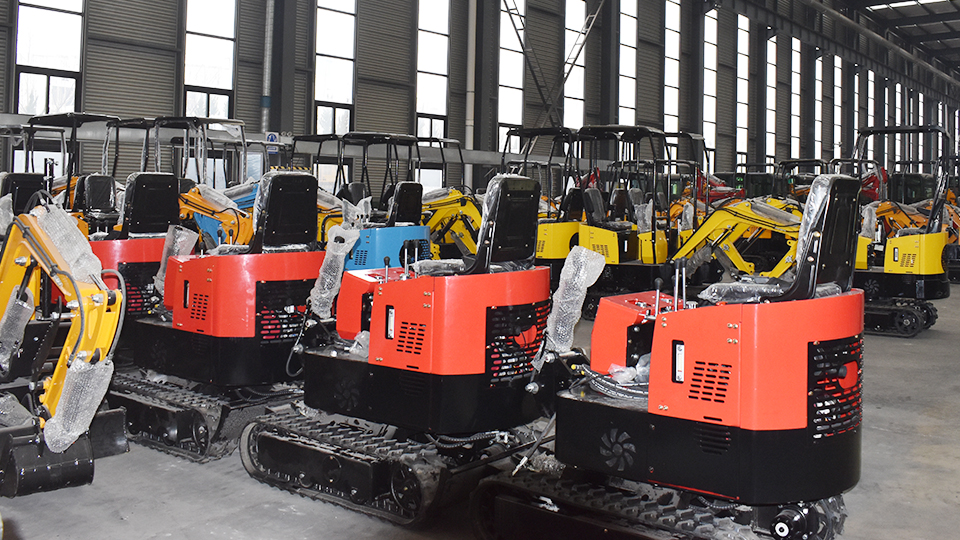1. The "Why": The Imperative of Professional Excavator Training
The risks associated with operating heavy machinery like excavators are significant. Without proper training, operators are prone to:
Accidents and Injuries: Excavators are powerful machines capable of causing severe injuries or fatalities if mishandled. Rollovers, striking buried utilities, trench collapses, and collisions with personnel or other equipment are real and constant dangers.
Property Damage: Incorrect operation can lead to extensive damage to infrastructure, surrounding property, and the excavator itself, resulting in costly repairs and project delays.
Inefficiency and Reduced Productivity: Untrained operators are slower, less precise, and more likely to make mistakes, leading to wasted time, fuel, and resources.
Legal and Financial Liabilities: Companies face hefty fines, legal action, and increased insurance premiums if accidents occur due to untrained personnel. Individuals may also face legal repercussions.
Environmental Damage: Improper digging can lead to erosion, contamination, or damage to natural habitats.
Damage to Machine: Incorrect operating procedures or lack of understanding of machine limitations can lead to premature wear and tear on components, significantly reducing the excavator's lifespan and increasing maintenance costs.
Professional training mitigates these risks by instilling the necessary knowledge, skills, and safety consciousness. It's an investment that pays dividends in safety, efficiency, and compliance.
2. Who Needs Excavator Training?
Essentially, anyone who will operate an excavator, regardless of experience level, can benefit from or requires formal training:
New Operators/Beginners: Individuals with no prior experience are the primary candidates. They need foundational knowledge and hands-on practice.
Experienced Operators: Even seasoned operators can benefit from refresher courses, updates on new technologies, safety standard changes, and advanced techniques. Bad habits can also be corrected.

Supervisors and Foremen: While not directly operating, supervisors need to understand safe operating practices to effectively oversee excavator operations and ensure compliance.
Maintenance Personnel: Understanding the basic operation and limitations of the machine is beneficial for those who maintain it.
Anyone on a construction site near heavy equipment: While not operating, awareness of safe operating zones and procedures is crucial.
3. Core Components of a Comprehensive Excavator Training Program
A high-quality excavator training program will encompass a blend of theoretical knowledge and practical, hands-on experience. Here are the essential elements:
A. Classroom (Theory) Instruction:
This phase lays the foundational knowledge, covering critical principles and regulations.
Introduction to Excavators:
Types of excavators (crawler, wheeled, mini, long-reach, zero-tail swing) and their applications.
Major components and their functions (boom, stick, bucket, undercarriage, cab, hydraulics, engine).
Basic mechanics and operating principles.
Safety Regulations and Standards:
OSHA (Occupational Safety and Health Administration) regulations (USA): Specific standards for construction, excavation, and heavy equipment operation (e.g., 29 CFR 1926 Subpart O for construction equipment, Subpart P for excavations).
ANSI (American National Standards Institute) and CSA (Canadian Standards Association) standards: Industry best practices and equipment-specific guidelines.
Site-specific safety rules: Understanding and adhering to the unique safety protocols of each job site.
Pre-Operation Inspections (Walk-Around Checks):
Why daily inspections are crucial.
Checkpoints: Fluids (oil, coolant, hydraulic), tracks/tires, hoses, electrical systems, lights, alarms, safety decals, attachments, and structural integrity.
Documentation of inspection findings.
Excavator Controls and Instrumentation:
Detailed explanation of joysticks, pedals, switches, and dashboard displays.
Understanding warning lights, gauges, and their significance.
Proper start-up and shut-down procedures.
Load Charts and Lifting Principles:
Understanding an excavator's lifting capacities based on reach, height, and attachment weight.
Center of gravity, stability triangle, and factors affecting stability (slopes, ground conditions).
Calculating safe working loads and avoiding overload.
Excavation Best Practices and Hazards:
Soil Mechanics: Basic understanding of different soil types (Type A, B, C) and their stability characteristics.
Trenching and Shoring: Safe practices for trenching, including sloping, shoring, and shielding requirements to prevent trench collapses.
Underground Utilities: Procedures for identifying, locating, and safely working around buried cables, pipes, and other utilities (e.g., "Call Before You Dig" protocols – 811 in the USA).
Spoil Piles and Sloping: Safe distances for spoil piles from trench edges.
Working on Slopes: Understanding stability limitations and safe operating angles.
Attachment Recognition and Use:
Buckets (digging, grading, trenching), hydraulic hammers, grapples, augers, compactors, quick couplers.
Safe attachment and detachment procedures.
Understanding the proper use and limitations of each attachment.
Site Management and Communication:
Hand signals for communication with ground personnel.
Two-way radio communication protocols.
Understanding site plans, blueprints, and grade stakes.
Working around other equipment and personnel.
Emergency Procedures:
What to do in case of a rollover, hydraulic line burst, fire, or striking a utility.
Emergency shut-down procedures.
First aid and reporting protocols.
Basic Maintenance and Troubleshooting:
Understanding basic maintenance requirements (greasing, filter changes).
Recognizing common machine faults and error codes.
B. Practical (Hands-On) Training:
This is where theory meets practice, under the direct supervision of experienced instructors.
Familiarization and Controls Practice:
Getting comfortable in the cab.
Practicing smooth and independent control of the boom, stick, bucket, and swing functions.
Mastering track/wheel control (forward, reverse, turning).
Pre-Operation Inspections in Practice:
Performing actual walk-around inspections on a real excavator.
Identifying potential issues.
Basic Maneuvering and Positioning:
Driving in various terrains and conditions.
Precision positioning of the machine.
Excavation Drills:
Leveling and Grading: Learning to create flat surfaces and precise slopes.
Trenching: Digging straight trenches of specified depth and width, maintaining grade.
Backfilling: Efficiently refilling trenches and excavations.
Loading Trucks: Practicing efficient and safe loading of dump trucks.
Spoil Pile Management: Creating and maintaining safe spoil piles.
Advanced Techniques (as applicable):
Digging around existing utilities.
Operating on slopes.
Precise material handling.
Using specialized attachments.
Safety Exercises:
Emergency shut-down drills.
Simulated encounters with hazards.
Communication drills with ground personnel.

C. Evaluation and Certification:
A reputable program concludes with a formal assessment to verify competency.
Written Examination: Testing theoretical knowledge of safety regulations, machine components, and operating principles.
Practical Examination: Hands-on assessment of the operator's ability to safely and efficiently perform tasks, including pre-operation checks, basic maneuvers, and excavation drills.
Certification: Successful completion results in a certification card or document, often valid for a specific period (e.g., 3-5 years), requiring periodic refresher training.
4. Choosing the Right Training Program: Key Considerations
Not all training programs are created equal. When selecting one, consider the following:
Accreditation and Recognition:
Is the program accredited by a recognized body (e.g., NCCER - National Center for Construction Education and Research, local vocational colleges, equipment manufacturers)?
Does it meet OSHA and other relevant industry standards?
Instructor Experience and Qualifications:
Are the instructors certified and do they have extensive, real-world experience operating excavators?
Are they effective communicators and patient teachers?
Curriculum Depth and Breadth:
Does it cover all the essential theoretical and practical components outlined above?
Is it up-to-date with current safety regulations and equipment technology?
Hands-On Time and Equipment Access:
How much actual seat time will be provided? This is crucial.
Is the training conducted on modern, well-maintained equipment?
Is there a sufficient instructor-to-student ratio during practical sessions?
Class Size: Smaller class sizes often allow for more personalized attention and hands-on time.
Training Environment: Is the training site safe and realistic, mimicking real-world job site conditions?
Cost and Duration: While cost is a factor, prioritize quality over cheapness. The duration should be sufficient to cover the material thoroughly (typically several days to a few weeks for comprehensive programs).
References and Reviews: Check testimonials from previous students or employers.
Job Placement Assistance (Optional): Some programs offer job placement assistance, which can be a valuable bonus.
5. The Benefits of Investing in Quality Training
For individuals and companies alike, the return on investment for quality excavator training is substantial:
Enhanced Safety Culture: A well-trained workforce contributes to a safer environment, reducing accidents, injuries, and fatalities.
Improved Productivity and Efficiency: Skilled operators work faster, more precisely, and make fewer errors, leading to project completion on time and within budget.
Reduced Operating Costs: Efficient operation minimizes fuel consumption, reduces wear and tear on machinery, and lowers maintenance and repair expenses.
Compliance and Risk Mitigation: Adherence to safety regulations avoids hefty fines, legal liabilities, and insurance complications.
Increased Equipment Lifespan: Proper operation and understanding of machine limits extend the life of the excavator, maximizing your asset investment.
Professional Development and Career Advancement: Certification opens doors to better job opportunities and higher earning potential for operators.
Boosted Morale: Operators who feel competent and safe are more confident and productive.
6. Beyond Initial Certification: Lifelong Learning
Excavator operation is a dynamic field. Continuous learning is vital:
Refresher Courses: Periodically refreshing knowledge and skills, especially as certifications expire, is crucial.
Advanced Training: Specialized courses for specific tasks (e.g., deep excavation, demolition, pipe laying, GPS-guided excavation) can enhance an operator's capabilities.
New Technology Training: As excavators incorporate more advanced electronics, telematics, and automation features, operators need training to utilize these effectively.
Manufacturers' Training: Attending training offered by excavator manufacturers can provide in-depth knowledge of specific models and their unique features.
Experience: While training provides the foundation, real-world experience under the guidance of experienced mentors is invaluable for honing skills and developing intuition.
Conclusion
Operating an excavator is a demanding yet rewarding profession. However, the immense power and potential hazards of these machines underscore the absolute necessity of rigorous, professional training. A comprehensive training program, covering theoretical knowledge, extensive hands-on practice, and thorough evaluation, is the bedrock of safe and efficient excavator operation. For aspiring operators, it's the gateway to a fulfilling career. For employers, it's an indispensable investment in safety, productivity, compliance, and the long-term success of their projects. Before any bucket hits the dirt, ensure that the operator has the knowledge, skills, and confidence that only quality training can provide.
Post time:Sep-25-2020
